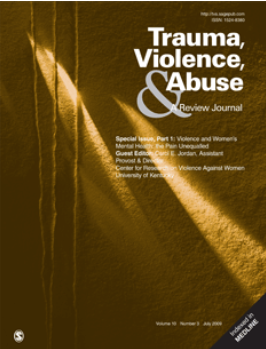A Systematic Review and Meta-Analysis of the Association between Childhood Exposure to Intimate Partner Violence and Intimate Partner Violence Victimization/Perpetration in Adulthood in Africa
IF 5.4
1区 社会学
Q1 CRIMINOLOGY & PENOLOGY
引用次数: 0
Abstract
Intimate partner violence (IPV) is widespread in many African countries. Evidence, mainly from Western countries, shows that exposure to IPV in childhood is an important risk factor for experiences of IPV in adulthood. However, to date, no systematic review has synthesized the evidence on this association for individuals living in Africa, which is the goal of the current study. We used three search strategies: database searches (e.g., MEDLINE and PsycINFO), manual searches, and machine learning tools (e.g., Connected Papers). We followed the Preferred Reporting Items for Systematic Reviews and Meta-Analyses guidelines and included peer-reviewed studies (in French or English) that reported quantitative or qualitative associations between childhood exposure to IPV and later IPV victimization/perpetration. A total of 48 studies from 29 African countries were included ( N = 520,000 participants). Pooled effects indicated an association between childhood exposure to IPV and IPV victimization for females (odds ratio [OR] = 2.46, 95% CI [2.09, 2.91], p < .001) and males (OR = 1.76, 95% CI [1.57, 1.97], p < .001). Similarly, males (OR = 1.92, 95% CI [1.60, 2.29], p < .001) and females (OR = 3.04, 95% CI [2.51, 3.69], p < .001) who were exposed to IPV in childhood were more likely to perpetrate IPV compared to those with no childhood exposure. Effect sizes varied substantially across studies (0.89–5.66), suggesting that other risk factors should be considered in future studies. This review provides unique insights on cycles of IPV in Africa that may usefully inform practice and research.对非洲儿童时期遭受亲密伴侣暴力与成年后遭受/实施亲密伴侣暴力之间关系的系统回顾和元分析
在许多非洲国家,亲密伴侣间的暴力行为(IPV)十分普遍。主要来自西方国家的证据表明,童年时期遭受 IPV 是成年后遭受 IPV 的重要风险因素。然而,迄今为止,还没有系统性综述对生活在非洲的个人的这种关联性证据进行综合,而这正是本研究的目标。我们采用了三种检索策略:数据库检索(如 MEDLINE 和 PsycINFO)、人工检索和机器学习工具(如 Connected Papers)。我们遵循《系统综述和荟萃分析首选报告项目》指南,纳入了同行评议的研究(法语或英语),这些研究报告了童年时期遭受 IPV 与日后 IPV 受害/施暴之间的定量或定性关联。共纳入了来自 29 个非洲国家的 48 项研究(N = 520,000 名参与者)。汇总结果表明,童年时期遭受 IPV 与 IPV 受害之间存在关联:女性(几率比 [OR] = 2.46,95% CI [2.09,2.91],p < .001)和男性(OR = 1.76,95% CI [1.57,1.97],p < .001)。同样,与童年时期未接触过 IPV 的人相比,童年时期接触过 IPV 的男性(OR = 1.92,95% CI [1.60,2.29],p < .001)和女性(OR = 3.04,95% CI [2.51,3.69],p < .001)更有可能实施 IPV。不同研究的效应大小差异很大(0.89-5.66),这表明在未来的研究中还应考虑其他风险因素。本综述对非洲的 IPV 周期提供了独特的见解,可为实践和研究提供有用的信息。
本文章由计算机程序翻译,如有差异,请以英文原文为准。
求助全文
约1分钟内获得全文
求助全文
来源期刊

Trauma Violence & Abuse
Multiple-
CiteScore
13.60
自引率
7.80%
发文量
131
期刊介绍:
Trauma, Violence, & Abuse is devoted to organizing, synthesizing, and expanding knowledge on all force of trauma, abuse, and violence. This peer-reviewed journal is practitioner oriented and will publish only reviews of research, conceptual or theoretical articles, and law review articles. Trauma, Violence, & Abuse is dedicated to professionals and advanced students in clinical training who work with any form of trauma, abuse, and violence. It is intended to compile knowledge that clearly affects practice, policy, and research.
 求助内容:
求助内容: 应助结果提醒方式:
应助结果提醒方式:


